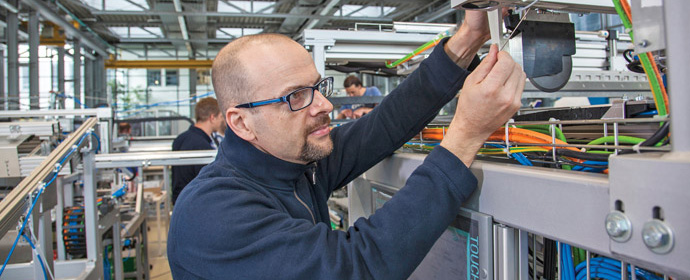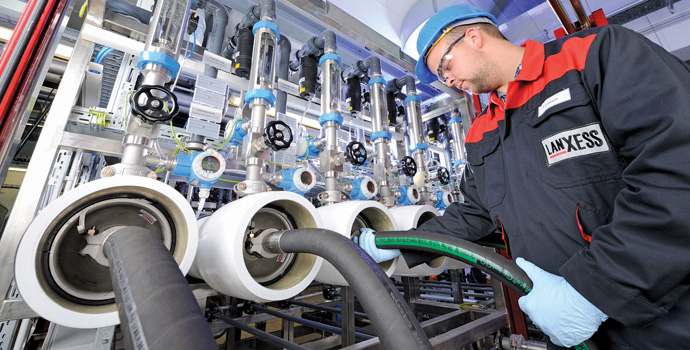The brightest minds in Saxony-Anhalt are used to changing the world.
Five hundred years ago, they altered the course of history by ushering in the Protestant Reformation in Wittenberg.
In more recent times, they produced the world’s first color film in Wolfen, first rubber synthesis in Buna, first synthetic plastics in Leuna, first all-metal airplane in Dessau, and first chilled casting in Magdeburg.
Fourteen years into the 21st century, the most innovative minds of this Central German state are creating the virtual building blocks that form the pillars of Europe’s modern industrial economy.
They are called “digital engineers,” and they are using the most cutting-edge tools of virtual-reality technology to build the new industrial machinery of the “Fourth Industrial Revolution” — one that combines the virtual and real worlds of manufacturing.
In Saxony-Anhalt, this breakthrough development is known as Industry 4.0, and it has already produced the dawn of the digital factory.
At LANXESS AG, a leading specialty chemicals company, this new digital technology enabled scientists to develop and build a plant in Bitterfeld for membrane filtration technology for water treatment in record time.
Researchers at the Fraunhofer Institute for Factory Operation and Automation in Magdeburg used revolutionary methods of digital engineering to allow research and development for the planning of products and manufacturing to proceed simultaneously.
The 30-million-euro membrane filter production plant in Bitterfeld was designed and built in just nine months using virtual-reality technology at Fraunhofer. The 4,000-square-meter investment project received about 8 million euros in incentives from the State of Saxony-Anhalt.
Today, the factory is one of the most modern plants of its kind in the world.
“Our Lewatit-brand ion exchange resins and Lewabrane RO membrane elements make us not only a leading one-stop-shop supplier in the water treatment field, but also the only producer of these membrane elements in Europe,” says Jean-Marc Vesselle, head of the LANXESS Liquid Purification Technologies business unit.
Others say that this new technology has global implications.
“With our technology and our products, we are able to contribute to the improvement of drinkable water supply worldwide,” says Dr. Carsten Schellenberg, head of the research laboratory at the Bitterfeld operation of LANXESS, a global company that employs 16,900 people in 31 countries and registered sales of 8.3 billion euros in 2013.
Schellenberg admits that this new plant would not have been built apart from the research and development work performed by Fraunhofer.
Due to the expedited timeline of this project, researchers had to quickly get up to speed on the special membrane filter technology employed by LANXESS.
“Research and development had to proceed in parallel, which is why we relied on virtual engineering from the outset,” says Prof. Ulrich Schmucker, manager of the Virtual Engineering Business Unit at Fraunhofer. “It enabled us to start work very early, which would not get done in a conventional approach until the final stage of development.”
Researchers at Fraunhofer were able to simulate filter elements on the computer. Other benefits of using virtual reality, says Schmucker, include:
- Simultaneous development and functional testing of all technology, equipment and machinery.
- Cost-effective custom development.
- Improved and expedited maintenance, repair and training.
“Digital engineering enables us to take a concept and go from idea to product in a totally virtual world,” states Schmucker. “All testing is done completely via digital engineering. We started using virtual-reality techniques at Fraunhofer in 1996, and about seven years ago we began using digital engineering to create the machines that run the new factories of the world.”
“Digital engineering enables us to take a concept and go
from idea to product in a totally virtual world.”
– Prof. Ulrich Schmucker, manager of the Virtual Engineering Business Unit at Fraunhofer Institute
Fraunhofer researchers focus on digital engineering techniques that create the specialized production machines used in the manufacturing plants of Saxony-Anhalt.
Saxony-Anhalt has a cluster of special-purpose machinery manufacturing and plant engineering that includes some 90 companies and research facilities in the state. Utilization of virtual technologies is a driving force of innovation at these plants.

At the heart of this industry is Magdeburg, known as an established center for the application of virtual technologies. The Otto-von-Guericke University Magdeburg and the Fraunhofer Institute together founded the Center for Digital Engineering.
LANXESS has established a close-knit alliance with this center, along with three Fraunhofer Institutes in Magdeburg and Halle, the Martin Luther University of Halle-Wittenberg, and the Leibnitz Institute in Dresden.
“About 25 percent of our funding comes from the German federal government, but the rest comes from industry for private research,” adds Schmucker. “LANXESS and other German companies come to us and seek our help in the design and construction of industrial machinery. We design and build their machines from scratch, using our methods and local machine builders, and then we teach our methods to them.”
Fangmann Energy Services GmbH Co. KG, an engineering and plant construction company in Salzwedel, is also taking advantage of digital engineering technology.
Researchers at the Fraunhofer Institute have created a learning application that enables Fangmann workers to employ digital engineering in their training. The company uses mobile free-fall conveyors to make sure that natural gas wells do not become diluted. Due to the inherent dangers of using this technology, it is better to train workers using a virtual reality environment.
“The qualification of our colleagues is reaching a new quality now,” said Fangmann CEO Steffan Gerdes of the new training technology being used by his company at Fraunhofer. “Thanks the three-dimensional presentation, they can virtually plunge into the facility and realistically train.”

This Investment Profile was prepared under the auspices of the Investment and Marketing Corp. of Saxony-Anhalt. For more information, contact Kristin Gabor, Regional Manager, at +49 391 568 99 22 or by email at
kristin.gabor@img-sachsen-anhalt.de. On the web, go to
www.invest-in-saxony-anhalt.com.
